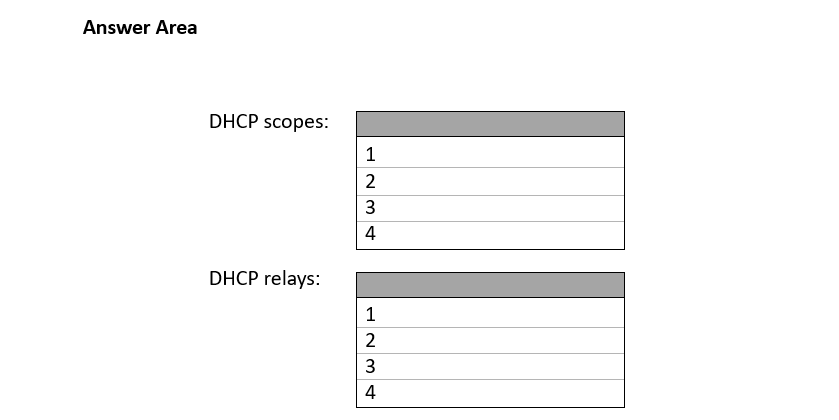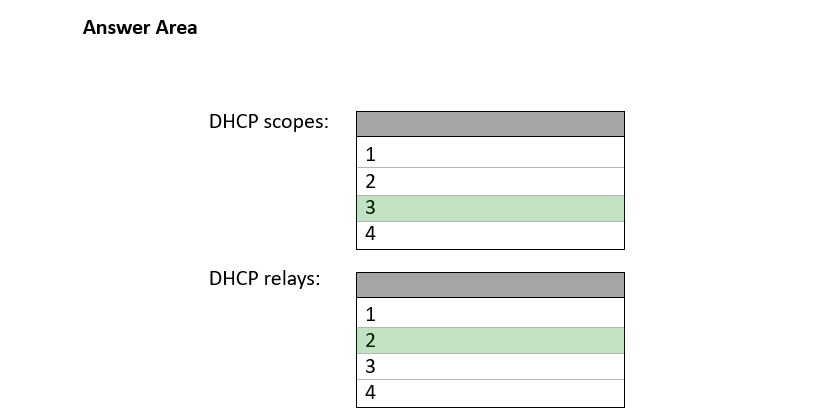SIMULATION
-
You need to enable nested virtualization for a virtual machine named VM1 on SRV1.
To complete this task, sign in the required computer or computers.
Answer:

SIMULATION
-
SRV1 contains a virtual machine named VM1.
You need attach c:\vhds\Disk1.vhdx to VM1. The solution must ensure that Disk1 can be expanded dynamically when VM1 runs.
To complete this task, sign in the required computer or computers.
Answer:

You have an Azure subscription that contains the virtual networks shown in the following table.
You deploy a virtual machine named VM1 that runs Windows Server. VM1 is connected to Subnet11.
You plan to add an additional network interface named NIC1 to VM1.
To which subnets can NIC1 be attached?
Answer:
B
DRAG DROP
-
You have an Azure subscription. The subscription contains a virtual machine named VM1 that runs Windows Server. VM1 contains a 128-GB operating system disk.
You need to increase the size of volume C on VM1 to 250 GB.
Which four actions should you perform in sequence.
To answer, move the appropriate actions from the list of actions to the answer area and arrange them in the correct order.
Answer:

HOTSPOT -
Your network contains two VLANs for client computers and one VLAN for a datacenter. Each VLAN is assigned an IPv4 subnet. Currently, all the client computers use static IP addresses.
You plan to deploy a DHCP server to the VLAN in the datacenter.
You need to use the DHCP server to provide IP configurations to all the client computers.
What is the minimum number of scopes and DHCP relays you should create? To answer, select the appropriate option the answer area.
NOTE: Each correct selection is worth one point.
Hot Area:
Answer:

Box 1: 3 -
You need a DHCP scope for each of the three subnets.
Box 2: 2 -
The two client VLANs need a DHCP Relay Agent to forward DHCP requests to the DHCP server. The datacenter VLAN that contains the DHCP server does not require a DHCP Relay Agent.
You have a server that runs Windows Server and has the DHCP Server role installed. The server has a scope named Scope1 that has the following configurations:
✑ Address range: 192.168.0.2 to 192. 168.1.254
✑ Mask: 255.255.254.0
✑ Router: 192.168.0.1
✑ Lease duration: 3 days
DNS server: 172.16.0.254 -
You have 50 Microsoft Teams Phone devices from the same vendor. All the devices have MAC addresses within the same range.
You need to ensure that all the Teams Phone devices that receive a lease from Scope1 have IP addresses in the range of 192.168.1.100 to 192.168.1.200. The solution must NOT affect other DHCP clients that receive IP configurations from Scope1.
What should you create?
Answer:
D
Reference:
https://docs.microsoft.com/en-us/previous-versions/windows/it-pro/windows-server-2012-R2-and-2012/dn425040(v=ws.11)
Note: This question is part of a series of questions that present the same scenario. Each question in the series contains a unique solution that might meet the stated goals. Some question sets might have more than one correct solution, while others might not have a correct solution.
After you answer a question in this section, you will NOT be able to return to it. As a result, these questions will not appear in the review screen.
You are planning the deployment of DNS to a new network.
You have three internal DNS servers as shown in the following table.
The contoso.local zone contains zone delegations for east.contoso.local and west.contoso.local. All the DNS servers use root hints.
You need to ensure that all the DNS servers can resolve the names of all the internal namespaces and internet hosts.
Solution: You configure Server2 and Server3 to forward DNS requests to 10.0.1.10.
Does this meet the goal?
Answer:
B
You have an on-premises network that is connected to an Azure virtual network by using a Site-to-Site VPN. Each network contains a subnet that has the same IP address space. The on-premises subnet contains a virtual machine.
You plan to migrate the virtual machine to the Azure subnet.
You need to migrate the on premises virtual machine to Azure without modifying the IP address. The solution must minim administrative effort.
What should you implement before you perform the migration?
Answer:
A
Reference:
https://docs.microsoft.com/en-us/windows-server/manage/windows-admin-center/azure/azure-extended-network
Note: This question is part of a series of questions that present the same scenario. Each question in the series contains a unique solution that might meet the stated goals. Some question sets might have more than one correct solution, while others might not have a correct solution.
After you answer a question in this section, you will NOT be able to return to it. As a result, these questions will not appear in the review screen.
You are planning the deployment of DNS to a new network.
You have three internal DNS servers as shown in the following table.
The contoso.local zone contains zone delegations for east.conloso.local and west.contoso.local. All the DNS servers use root hints.
You need to ensure that all the DNS servers can resolve the names of all the internal namespaces and internet hosts.
Solution: On Server2 and Server3, you configure a conditional forwarder for contoso.local.
Does this meet the goal?
Answer:
B
You have servers that have the DNS Server role installed. The servers are configured as shown in the following table.
All the client computers in the New York office use Server2 as the DNS server.
You need to configure name resolution in the New York office to meet the following requirements:
✑ Ensure that the client computers in New York can resolve names from contoso.com.
✑ Ensure that Server2 forwards all DNS queries for internet hosts to 131. 107.100.200.
The solution must NOT require modifications to Server1.
Which two components should you configure on Server2? Each correct answer presents part of the solution.
NOTE: Each correct selection is worth one point.
Answer:
AB
A conditional forwarder is required for contoso.com.
A forwarder is required for all other domains.
When you have a conditional forwarder and a forwarder configured, the conditional forwarder will be used for the specified domain.
You could use a secondary zone for contoso.com but that would require a configuration change on Server1.